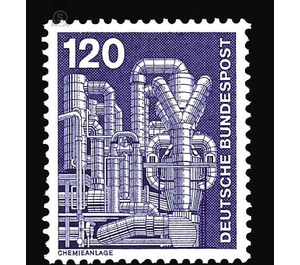Postage stamps: industry and technology - Germany / Federal Republic of Germany 1975 - 120 Pfennig
Theme: Architecture
| Country | Germany / Federal Republic of Germany |
| Issue Date | 1975 |
| Face Value | 120.00 |
| Color | violet |
| Perforation | K 14 |
| Printing Type | Typography |
| Stamp Type | Postage stamp |
| Item Type | Stamp |
| Chronological Issue Number | 744 |
| Chronological Chapter | GER-BRD |
| SID | 589985 |
| In 74 Wishlists | |
A new postage stamp continuous series with representations from industry and technology replaces the postage stamp continuous series "Federal President Heinemann". The postage stamps to 80 Pfennig, 120 Pfennig and 160 Pfennig appear as further values of this series with the inscription Deutsche Bundespost (at the same time and same motives the stamps come out also with the inscription Deutsche Bundespost Berlin, the first three values are on 15 May 1975, further three values were issued on August 14, 1975) have the following motifs: 120 Pf: Chemical plant A production plant of BASF Aktiengesellschaft in Ludwigshafen is shown for the production of styrene (vinylbenzene, phenylethylene). Styrene is of particular importance as a starting material for plastics production. Soon after the initial isolation of benzene, chemically-related vinylbenzene was also discovered as part of the Storax (Styrax) vegetable wound balm, which was obtained by boiling the bark of the sweetgum tree. The Berlin pharmacist Eduard Simon gave 1839 of the water-bright, strongly refractive liquid, which he received from the essential oil of the Storaxbalsams, the designation "styrene". He was also the first to observe the transformation of this liquid by heat, light and air to a solid resin. The first development work in this field was carried out at BASF in Ludwigshafen, where, from 1930, ethylene styrene could be used to produce monomeric styrene and polymerize the plastic polystyrene on an industrial scale. The large-scale synthesis is carried out today by alkylating the benzene to ethylbenzene and subsequent dehydration of this compound. By polymerization, i. By chemically linking about 1,000 individual molecules of styrene, one obtains a giant molecule, polystyrene, a solid substance that is virtually indistinguishable from glass in appearance. Polystyrene resins are an important group of thermoplastics that are solid bodies at normal temperatures, but become deformable when heated. The polymers of styrene and copolymers are used because of their interesting technical properties (strength, toughness, gloss, high electrical insulation) in countless areas in ever larger quantities. World production of plastics in 1973 was just over 40 million tons; Of this, the Federal Republic of Germany accounted for approximately 6.5 million tonnes.


